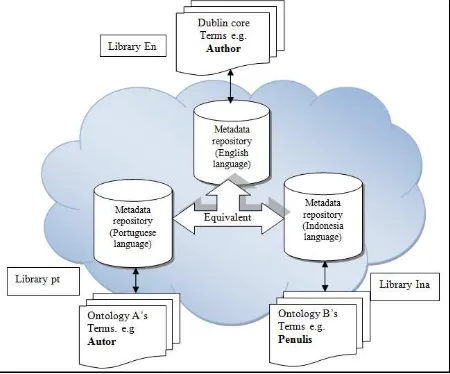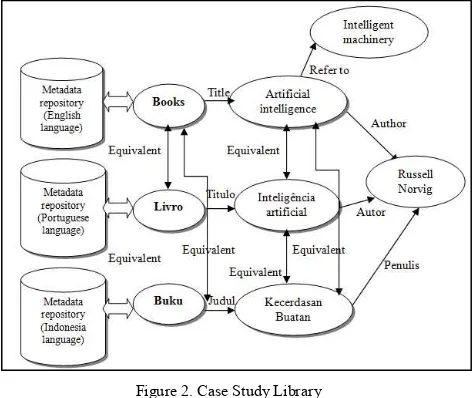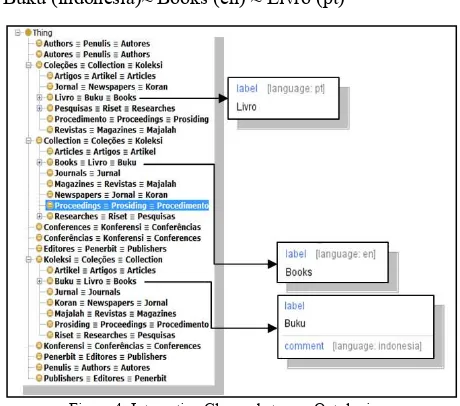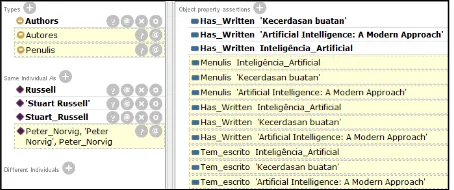SOLVING DIFFERENT LANGUAGES PROBLEM (PORTUGUESE,
ENGLISH and BAHASA INDONESIA) IN DIGITAL LIBRARY WITH
ONTOLOGY
Herlina JAYADIANTI a,b , Carlos Sousa PINTOb, Lukito Edi NUGROHO c, Paulus Insap SANTOSA d, Wahyu WIDAYAT e
a, Universitas Gadjah Mada, Electrical Engineering and Information Technology, Yogyakarta, Indonesia, [email protected]
bMinho University,Information System Department,Campus Azurém, Guimaraes, Portugal, [email protected] c,dUniversitas Gadjah Mada, Electrical Engineering and Information Technology, Yogyakarta, Indonesia,
{lukito, Insap}@mti.ugm.ac.id
eUniversitas Gadjah Mada, Faculty of Economic and Development, Yogyakarta, Indonesia, [email protected]
ABSTRACT
In this paper we will present in how digital library work for different language support, perhaps in a different repositories and in a different countries. Our works requires available collections in one metadata associated with each collection in another metadata and build a relation between each metadata in each repository. In this paper we will use three languages from three different repositories, such as Indonesia, English, and Portuguese. it is very important to make a connection between references in different languages (English, Portuguese and Indonesia) in a large metadata; this is aim of our work. Ambiguity, equivalences and semantics problem will appear in this situation, and we will try to solve this problem trough this work.
Keywords: Ontology, Library, References, Different languages, Indonesia, English, Portuguese.
1
INTRODUCTION
A digital library is a repository of digital documents of different files formats like.pdf, .doc, .ppt or even plain .txt which can be any journal, newspaper, books, magazines, instruction manuals, presentations and others publications. Nowadays Ontology is very important for making an efficient searching in digital library [1], [2], [3], [4]. Ontology based digital library should have the additional features of semantic based accessing / querying and searching the library using a reference ontology to reform the user query and extract only appropriate content from the library. In this section we will present a future face of digital library, it will work for different language support, perhaps in a different country. In summary, our works requires available collections in one library (references in English) associated with each collection in another library (references in Portuguese and Indonesia).
Figure 1. Metadata Architecture
6-08 Solving Different Languages Problem (portuguese, English And Bahasa Indonesia) In Digital Library With Ontology
We give an illustration (Figure1) there are three metadata repositories, in English, in Portuguese and in Indonesian language. Our aim is to build a relation between each metadata in each repository. Indonesian reader often searching literatures or references in English and Indonesian language, similarly, in country such as East Timor, people use more than three languages to communicate – Portuguese, English, Indonesia and local language. Alongside Malay, Portuguese was the language that is absorbed by the Indonesian language. We can say that it is very important to make a connection between references in different languages (English (En) – Portuguese (pt) – Indonesia (ina)) in a large metadata. The term “reference” is a relation between objects in which one object connects or link to another object. The first object in this relation is said to refer to the second object. The second object – the one to which the first object refers – is called the referent of the first object. As an example:
Book (1): Artificial intelligence a modern approach by Author (1) Russell Norvig (first object) refers to: Book (2): Intelligent machinery by Author (2) Alan Turing (second object).
Figure 2. Case Study Library
Base on Figure 2 : Books (En) ≈ Livro (pt) ≈ dictionary for English. WordNet implements measure of similarity and relatedness among terms [5] [6]. Measures of similarity use information found in an is–a
1 http://wordnet.princeton.edu/
hierarchy of concepts, and quantify how much concept A is similar to concept B.
2
SEMANTIC HETEROGENEITY
Semantic heterogeneity occurs when the same reality, modeled by two or more people, does not have the same model or representation [7], [8], [9]. In this research we consider different conceptualizations (sets of terms) about library that cause a semantic heterogeneity problem. Section 1 (introduction) describes the concept of library and the different perceptions of it. Since the representations or models of library are independently developed, they often have different structures, terminologies, or even interpretations, representing an obstacle for semantic interoperation of those models. Semantic heterogeneity problem takes place on naming, scaling and
confounding [10], [11]. Semantic heterogeneity on naming includes problems with synonyms (same concept with different terms of concepts and their properties, e.g. Education and school background) and homonyms (same term with different semantics, e.g.
Worm as animal, as muscle under tongue and as infection in computers). Semantic heterogeneity problem in confounding occurs when one concept can refer different realities and has an effect on the attribute values. For example, latestmeasuredtemperature
doesn’t refer one and the same instant.
3
ONTOLOGY INTEGRATIONS
Ontology consists of classes, data properties, object properties, and instances. Instances are objects which cannot be divided without losing their structural and functional characteristics. Data properties and object properties are related and operate among the various objects populating the ontology. Ontology integration is one way to solve the problem of semantic heterogeneity and can be done using several approaches. For example, merging, matching or mapping. In our case, we decided to use mapping process because with mapping we can find the similarities and correspondences between terms of the ontologies. Mapping works with logical axioms, typically expressing logical equivalence or inclusion among ontology terms. The integration of ontologies creates a new ontology by reusing other available ontologies through assembling, extending, or specializing operations. In integration processes the source ontologies and the resultant ontology can have different amounts of information [9].
The goal of ontology integration is to derive more general domain ontology (common ontology) from several other ontologies in the same domain, into a consistent unit. The domain of both the integrated and The Proceedings of The 7th ICTS, Bali, May 15th-16th, 2013 (ISSN: 9772338185001)
the resulting ontologies is the same. Figure 3 shows an example with several source ontologies (Oen, Oina, Opt) and the integrated common ontology (CO - Oen).
Figure 3. Integration of ontologies
Ontology integration process implies several steps. Finding similarities and differences between ontologies in an automatic and semi-automatic way;
Defining mappings between ontologies;
Developing an ontology integration architecture; Composing mappings across different ontologies; Representing uncertainty and imprecision in
mappings.
Particularly, in ontology integration, some tasks should be performed to eliminate differences and conflicts between those ontologies. The task lies at two levels: language level and ontology level [12]. Base on Figure 3 we can see that Ontology En (OEn) from library which is majority of the books is with English language literature integrated with repository in Portuguese language in ontology Pt (Opt) and repository in Indonesian language in Ontology Ina (Oina). Importing process is one way to integrate ontologies. When an ontology imports another ontology, all the definitions about classes, properties and individuals of the imported ontology becomes available to the importing ontology. Here Ontology
English (Oen) is a common ontology because it
will use a more common term for English, Portuguese and Indonesian people than Portuguese language or Indonesian language.We will use an Ontology Web Language (OWL), a language to create ontologies for the Web, we can implement the referred process of importing. The code below describes how the
owl:imports mechanism works and how OWL
resolves the location of an ontology, given its URI. <owl:Ontology
The importing process, as explained before, allows us to obtain a new ontology, a Common Ontology (CO), consisting of common terms. Common term is a common word recognized and used by different sets of people. In this project we use an English as a common term, because English language is more common than Portuguese and Indonesia. Label : [language : Indonesia]
Class : Buku
Buku SubClassOf Koleksi Label : [language : pt] Class : Livro
Livro SubClassOf Coleções Label : [language : en] Class : Books
Books SubClassOf Collection
Buku (indonesia)≈ Books (en) ≈ Livro (pt)
Figure 4. Integrating Classes between Ontologies
Figure 4 shows the relationship scheme
between terms in the considered O’s and the common
terms in the CO. The class Editores (Opt), is the class that represents publisher in Portuguese language, is equivalent to class Penerbit (Oina), If the differences in perception of this problem occur among a group of
ontologies (as an example we can use ontology english (oen) and ontology portuguese (opt) and ontology indonesia (oina) describing their respective perceptions about library (see Figure 4 and Figure 5). Three ontologies (oen, opt and oina) have a class refer to 6-08 Solving Different Languages Problem (portuguese, English And Bahasa Indonesia) In Digital Library With Ontology
“collection” which represents each collection record
(see figure 5).
Figure 5. Ontograph Visualization Between Class Books(Oen), Buku(Oina) And Livro(Opt)
The three ontologies look rather different, the information that they capture is roughly the same but they use a different language, english laguange, portuguese language and indonesian language. We can say that class buku belonging to the ontology oina is equivalence to the class livro in ontology opt. Class buku (oina) and class livro (opt) represent the same semantic value. Not only the classes are integrated, we also integrate the dataproperties, objectproperties and instances. Considering the same example we can say that classes artikel(oina) and artigos (opt) are equivalent – they represent various article but have different terms.
5
ONTOLOGY MAPPING
After the ontology integration process is complete, the next step should be the execution of a mapping process. The main purposes of mapping processes are to find similarities between the source ontologies through logical axioms, logical equivalences and inclusions among ontology terms. We can do
“mapping” between classes, properties and individuals. Mapping can be done by using automatic, semiautomatic or interactive reasoning. The results of
“mapping” are used with various purposes such as data
transformation, query answering and data integration. According to Noy [13] there are four dimensions of ontology mapping:
Mapping discovery: Given two ontologies, find similarities between them and determine which concepts and properties represent similar notions; Interactive specification of mapping: Use tools that
interactively allows to define and compare ontologies and mappings with automatic or semi-automatic help;
Use declarative formal representation of mapping; Do reasoning with mapping.
For instance, we can say that the Class Book in Figure 4-6 is equivalent to the Class Livro. ObjectProperties Has_Written is equivalent to ObjectProperties Menulis. As an important note that
ObjectProperties Has_Written exist in Oen and ObjectProperties Menulis exist in Oina, but through ontology mapping and importing process now we can integrated them in one ontology.
Figure 6. Object Properties Equivalence - Owl: EquivalentProperty
In this section, we can see a testing result of ontologies mapping. We use SPARQL.
Prefix :
WHERE { ?Books :Written_by ?Authors. ?Authors :AuthorName ?Value
FILTER (?Value = 'Stuart Russell' )}
Figure 7.OntoGraph visualization between Class Books(Oen), Buku(Oina) and Livro(Opt)
Base on Figure 7 we can see that references
“Inteligência artificial”from (Opt) is
equivalence to Artificial intelligence from (Oen) and Kecerdasan Buatan from (Oina). So only with one term “Book”, SELECT ?Books ?Authors, system
can understand what user want. System will
give a result not from Oen, book Artificial
intelligence but also will give a result from Opt and
Oina.
Ontology mapping can be applied in various domains not only library. We can use ontology mapping process to help us to find semantic correspondences between similar or different elements of different ontologies in any domain. In this paper we also focus in a SPARQL query process which can be used to achieve interoperability in semantic information The Proceedings of The 7th ICTS, Bali, May 15th-16th, 2013 (ISSN: 9772338185001)
retrieval and/or knowledge discovery processes over interconnected RDF data sources. Formal mappings between different overlapping ontologies are exploited in order to rewrite initial user SPARQL queries, so that they can be evaluated over different RDF data sources on different places. different semantic, different terms and different language from different user query so it will be very easy for user from different languages find references related to their own knowledge and language.
7
ACKNOWLEDGEMENT
We would like to acknowledge the support of the Erasmus Mundus EuroAsia program for the research foundation of this research, and also to acknowledge Universidade do Minho Portugal and Universitas Gadjah Mada Yogyakarta Indonesia for the
ontological to hermeneutical systems,” Research and Advanced Technology for Digital Libraries, pp. 914–914, 2001.
[2] S. Buckingham Shum, E. Motta, and J. Domingue,
“ScholOnto: an ontology-based digital library server for research documents and discourse,”
International Journal on Digital Libraries, vol. 3, no. 3, pp. 237–248, 2000.
[3] M. Doerr, J. Hunter, and C. Lagoze, “Towards a
core ontology for information integration,”
Journal of Digital information, vol. 4, no. 1, 2003. [4] L. Rajput and S. Shyam, “Ontology based digital
library,” 2010. [Online]. Available:
http://dl.acm.org/citation.cfm?id=1742233. [Accessed: 27-Jan-2013].
[5] C. Fellbaum, WordNet. Springer, 2010.
[6] T. Pedersen and V. Kolhatkar, “WordNet:: SenseRelate:: AllWords: a broad coverage word
sense tagger that maximizes semantic relatedness,”
in Proceedings of Human Language Technologies: The 2009 Annual Conference of the North American Chapter of the Association for Computational Linguistics, Companion Volume: Demonstration Session, 2009, pp. 17–20.
[7] K. Janowicz, “The role of space and time for
knowledge organization on the semantic web,”
Semantic Web, vol. 1, no. 1, pp. 25–32, 2010. [8] V. Morocho, F. Saltor, and L. Perez-Vidal,
“Ontologies: Solving semantic heterogeneity in a federated spatial database system,” in In Proceedings of 5th International Conference on Enterprise Information System, 2003.
[9] Y. Xue, “Ontological View-driven Semantic
Integration in Open Environments,” The
University of Western Ontario, 2010.
[10] I. Boukhari, L. Bellatreche, and S. Jean, “An ontological pivot model to interoperate
heterogeneous user requirements,” in Leveraging Applications of Formal Methods, Verification and Validation. Applications and Case Studies, Springer, 2012, pp. 344–358.
[11] L. Bellatreche, G. Pierra, and E. Sardet,
“Evolution Management of Data Integration
Systems by the Means of Ontological Continuity
Principle,” in Recent Trends in Information Reuse and Integration, Springer, 2012, pp. 77–96. [12] N. F. Noy, M. Crubézy, R. W. Fergerson, H.
Knublauch, S. W. Tu, J. Vendetti, and M. A.
Musen, “Protégé-2000: An Open-Source Ontology-Development and Knowledge-Acquisition Environment: AMIA 2003 Open
Source Expo,” in AMIA Annual Symposium Proceedings, 2003, vol. 2003, p. 953.
[13] N. F. Noy, “Ontology mapping,” Handbook on ontologies, pp. 573–590, 2009.
6-08 Solving Different Languages Problem (portuguese, English And Bahasa Indonesia) In Digital Library With Ontology
The Proceedings of The 7th ICTS, Bali, May 15th-16th, 2013 (ISSN: 9772338185001)
[This page is intentionally left blank]



